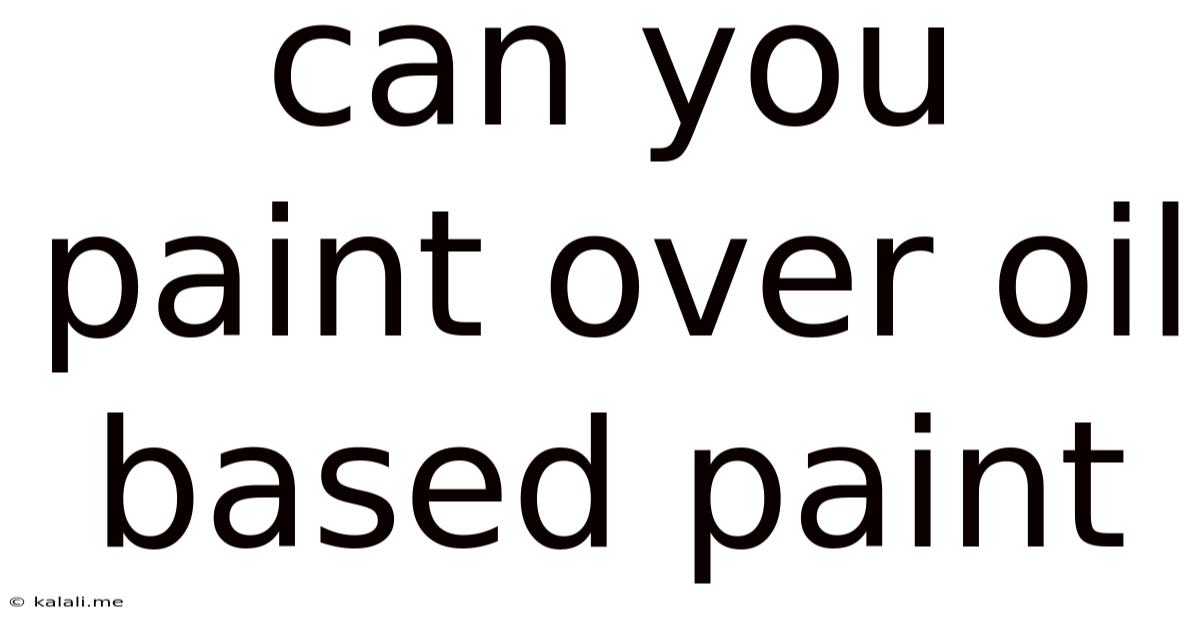Can You Paint Over Oil Based Paint
Kalali
Jun 10, 2025 · 4 min read

Table of Contents
Can You Paint Over Oil-Based Paint? A Comprehensive Guide
Meta Description: Wondering if you can paint over oil-based paint? This guide explores the challenges, best practices, and essential steps for successfully painting over existing oil-based finishes, ensuring a durable and long-lasting result. Learn about surface preparation, primer selection, and paint choices for optimal results.
Painting over oil-based paint is possible, but it requires careful planning and execution. Unlike water-based paints, oil-based paints take significantly longer to dry and form a hard, durable finish. This characteristic, while beneficial in the long run, presents unique challenges when repainting. Successfully painting over oil-based paint hinges on proper surface preparation and the selection of the right materials. Let's delve into the details.
Understanding the Challenges of Painting Over Oil-Based Paint
The primary challenge lies in the oil-based paint's inherent properties. Its slow drying time means the underlying layer may not be fully cured before applying a new coat. This can lead to:
- Poor adhesion: The new paint may peel or chip easily if it doesn't properly bond with the underlying oil-based layer.
- Yellowing: Oil-based paints can yellow over time, and this discoloration might show through the new paint, especially with lighter shades.
- Chemical reactions: Incompatibility between the old and new paint types can cause reactions leading to a poor finish.
Essential Steps for Successful Repainting
To overcome these challenges and ensure a successful paint job, follow these crucial steps:
-
Thorough Cleaning: Start by thoroughly cleaning the surface to remove dirt, dust, grease, and any loose or flaking paint. Use a suitable cleaner and allow ample drying time. Consider using a degreaser for particularly greasy surfaces.
-
Surface Preparation is Key: This is arguably the most crucial step. Proper surface preparation will guarantee a long-lasting paint job. Carefully scrape away any loose or peeling paint. Sand the surface smoothly using fine-grit sandpaper to create a good surface for adhesion. Remember to use appropriate safety equipment, like a dust mask and safety glasses.
-
Primer Selection: Using the right primer is critical. A high-quality oil-based primer or a stain-blocking primer designed for use over oil-based paints will provide the best adhesion and prevent the old paint from bleeding through. Apply the primer in thin, even coats, allowing each coat to dry completely before applying the next.
-
Choosing the Right Paint: While you can use oil-based paint over oil-based paint, it's often recommended to use a high-quality acrylic paint. Acrylic paints are water-based, offering easier cleanup and less odor, while still providing a durable finish. Make sure your chosen paint is compatible with the primer.
-
Applying the Paint: Apply the paint in thin, even coats, using a high-quality brush or roller. Avoid overloading the brush or roller, and work in a consistent direction to avoid streaks. Allow each coat to dry completely before applying the next.
-
Multiple Thin Coats: Instead of applying one thick coat, apply several thin coats for a smoother, more even finish. This allows for better penetration and adhesion.
Choosing Between Oil-Based and Water-Based Paint Over Oil-Based Paint
While using oil-based paint over oil-based paint might seem logical, using an acrylic latex paint over a properly prepared surface usually offers several advantages:
- Easier Cleanup: Water-based paints are significantly easier to clean up with soap and water.
- Lower VOCs: Water-based paints generally have lower volatile organic compounds (VOCs), making them a more environmentally friendly choice.
- Faster Drying Time: Though still longer than most water-based paint over other surfaces, water-based paint will generally dry quicker over oil-based paint that is properly prepped and primed.
Conclusion: Patience and Preparation are Key
Painting over oil-based paint is achievable with the right approach. Prioritizing thorough surface preparation, primer selection, and multiple thin coats of high-quality paint will ensure a durable and aesthetically pleasing finish that lasts. Remember patience is key; allow ample drying time between each step for optimal results. By following these steps, you can successfully transform your surfaces with a fresh coat of paint, regardless of the underlying oil-based layer.
Latest Posts
Latest Posts
-
How Many Tablespoons Are In 1 2 Ounce
Jul 01, 2025
-
How To Beat Level 29 On 40x Escape
Jul 01, 2025
-
Theres A Leak In This Old Building Lyrics Meaning
Jul 01, 2025
-
If I M 19 What Year Was I Born
Jul 01, 2025
-
How Many Pounds Are In 900 Grams
Jul 01, 2025
Related Post
Thank you for visiting our website which covers about Can You Paint Over Oil Based Paint . We hope the information provided has been useful to you. Feel free to contact us if you have any questions or need further assistance. See you next time and don't miss to bookmark.